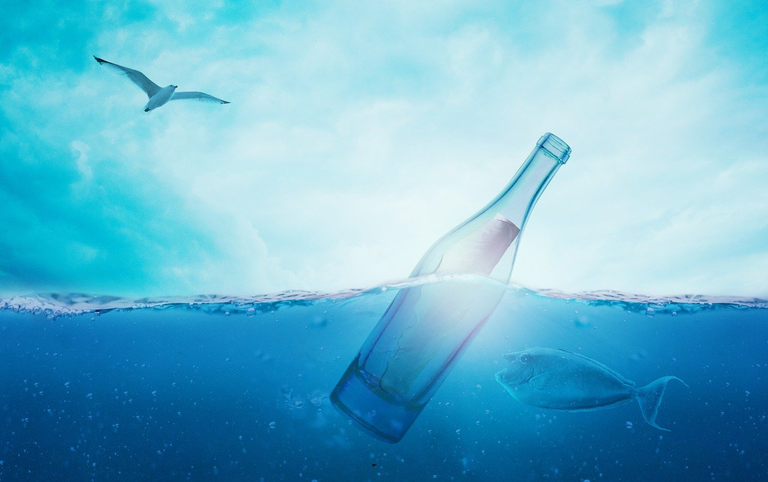What exactly gives the oceans their Blue colour - let's find out together!!
Close your eyes and picture the water. Is there a certain color you can recall? Your inner vision is most likely colored a calming blue. Generations of humans have been mesmerized by the ocean's deep blue because of the peace and mystery it represents. Have you ever wondered why the ocean always seems to be the same shade of blue? Is there any way science may shed light on this intriguing phenomenon?
The beautiful blue hue of the ocean and its origins will be discussed in further detail as we delve into the physics of light, scattering, and water molecules. The fascinating subject of physics is the source of this apparently mystical answer. Why does the water reflect such a lovely hue? That's a question for the realm of color theory, which we'll explore now.
As we explore the interesting interplay between light and matter, the enigmatic mechanisms that generate the blue hues of the ocean will become clear. We will investigate the scientific processes at play in this stunning natural phenomena, including the sun's dispersion and the water molecules' ability to absorb and reflect light.
But hold on, before we go too far into this underwater paradise, let's take a moment to appreciate the impact of point of view. Is your adventurous spirit up for the challenge of exploring uncharted waters and learning the secrets underlying the ocean's ageless allure? Let's go out on a scientific quest to discover where one of the world's most known colors comes from.
Let's start with a discussion - the physics of Light
How fascinating is the physics of light? It's an intriguing inquiry into the hidden mechanisms of human color perception. Now you know that there is more to light than what the eyes can see. The mysterious blue color of the ocean may be explained by this intricate phenomena.
First, let's cover the fundamentals. Light is a kind of electromagnetic radiation that transmits energy from its source along its wavefront as it moves through space. The spectrum of colors we see results from the varying wavelengths of these waves. Each hue, from hot reds and oranges to cold blues and purples, represents a certain spectrum of light.
But how exactly does light refract off of materials to produce various hues? The key is, of course, dispersion. To avoid being absorbed or scattered, light may deflect off of molecules or small droplets. The way we see colors is heavily influenced by this scattering process.
Fragmentation Due to Rayleigh Scattering
You know, there's this phenomena called Rayleigh scattering that really stands out when trying to explain the scientific basis for the ocean's dazzling blue color. It's like a magician at work, conjuring up the stunning colors that steal our breath away.
Imagine sunlight pouring down from the sky, struggling to penetrate Earth's atmosphere. It travels through the air and comes into contact with innumerable gas molecules and microscopic particles. The exciting part is about to begin. These minute particles excel at dispersing light, and the color blue seems to have a special place in their hearts.
Sunlight scatters when it interacts with these particles. However, unlike longer wavelengths like red and green, the more easily dispersed blue and violet light is. when a result, only the blue wavelengths of sunlight are significantly altered when they pass through the atmosphere on their approach to Earth.
The result is the stunning blue of the daytime sky. The sky is bathed in an alluring azure tint thanks to the dispersed blue light, providing a picturesque setting for the clouds, birds, and the activities of our daily lives. But hold on, we're supposed to be discussing the sea, right?
As it turns out, the blue light that has been spread doesn't simply sit on the ocean's surface. Another performance of Rayleigh scattering takes place in the ocean's wet embrace. When sunlight passes through water, it is absorbed by molecules that are eager to take in the longer wavelengths of red and green light while rejecting the blue light that is their preference.
In such case, what comes next? Freed from the bonds of water molecules, the blue light spreads forth, bathing us in its calming and regal hue. It's as if the ocean is conducting an orchestra of dispersed light, producing music for our hearts and minds.
The greatest part is that Rayleigh scattering is not just to thank for the beauty of sunrises and sunsets, but also for the blue wonder of the ocean. When the sun is low in the sky, more of the atmosphere must be traversed by its rays before they reach Earth. The longer path causes the shorter wavelengths to disperse even further, leaving behind the warm, golden tones that color the sky at that time.
Ocean Color and Its Influencers

Source
There are a number of variables that may affect the color of the water, resulting in a wide range of hues. It's more complicated than just being "blue all the time." Let's dig in and learn more about what causes the ocean's breathtaking color palette to change.
Let's start with the depth of the water. Color perception may be drastically altered by the water's depth. The water's color may seem like a vivid turquoise or even an emerald green in shallow regions where sunlight can reach the ocean bottom and reflect back. The sun's rays are reflected by the sandy or rocky bottom, giving the water an extra dose of color.
However, water molecules themselves absorb more sunlight as depth increases. This absorption mechanism has variable effects on various colors of light. Red and green light are absorbed more quickly, altering the apparent color, whereas blue light is diffused and may travel further. As a result, the ocean's depths may seem to be a darker or richer blue.
The presence of pollutants is a further aspect that might affect ocean color. Dissolved organic materials, sediments, and even microorganisms are all examples of possible contaminants. They may disperse and absorb light, changing the color of the ocean as a whole. If there's a lot of algae in the ocean, for instance, the water will take on a greenish tinge, giving the sea a vivid, surreal appearance.
Ocean color may also be affected by particles in suspension. Dust and even minuscule plankton might fall within this category. Color perception is altered because of the scattering of light by these particles. Areas with large concentrations of suspended particles may cause the water to take on a greyer or even browner hue, giving the impression of murkiness or cloudiness.
It's intriguing to consider how all of these variables work together to produce the wide spectrum of colors seen on our planet. Every shade of blue in the ocean has its own narrative to tell, from the bright turquoise of the Caribbean to the dark indigo of the wide sea.
We are reminded of the delicate dance of light and the beauties of nature as we draw to a close our investigation into the fascinating question of why the ocean always seems so brilliantly blue. Rayleigh scattering, in addition to water depth and pollutants, paints a different picture on the ocean's canvas. If you happen to find yourself near the water again, I hope you'll pause to contemplate the science and magic that give the ocean its enduring allure of blue.
References
- facts about ocean blue from ocean service
- Why is ocean blue from ocean literacy
- Why does the ocean appear blue? Isit because it reflects the color of the sky?
- Everyday mystery
- Starts with a bang




Thanks for your contribution to the STEMsocial community. Feel free to join us on discord to get to know the rest of us!
Please consider delegating to the @stemsocial account (85% of the curation rewards are returned).
You may also include @stemsocial as a beneficiary of the rewards of this post to get a stronger support.